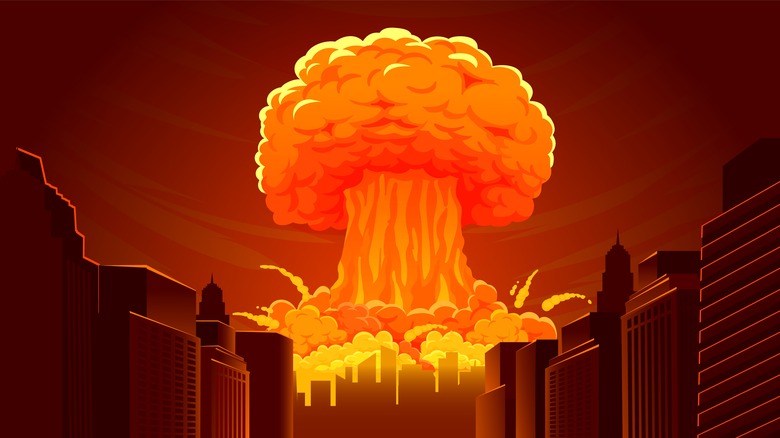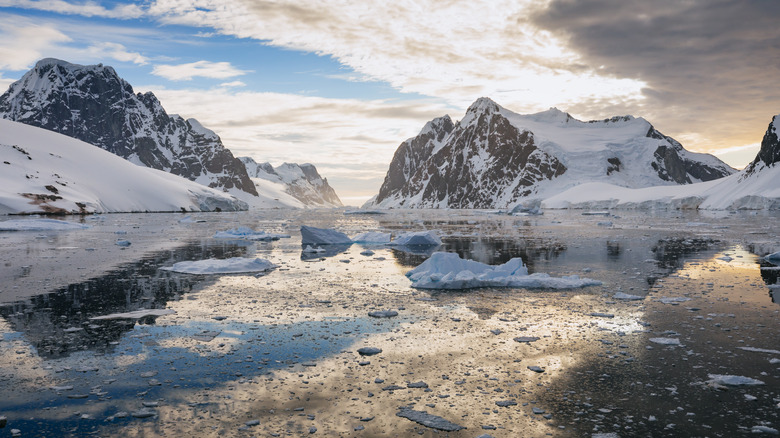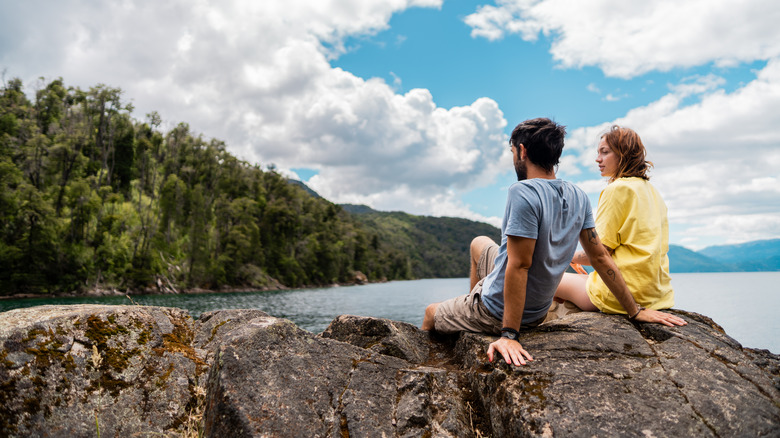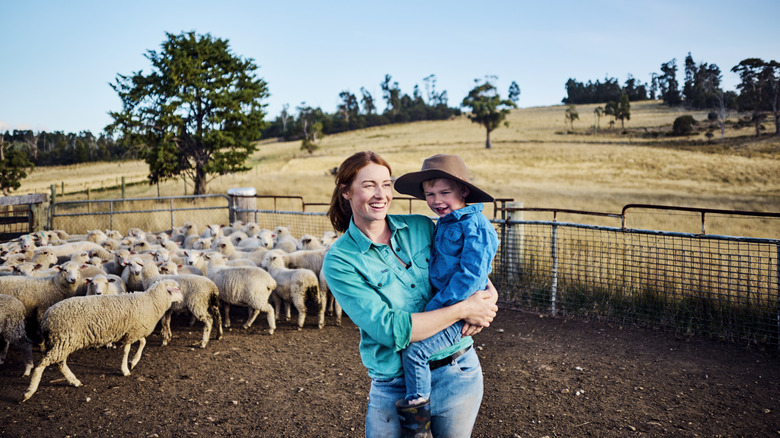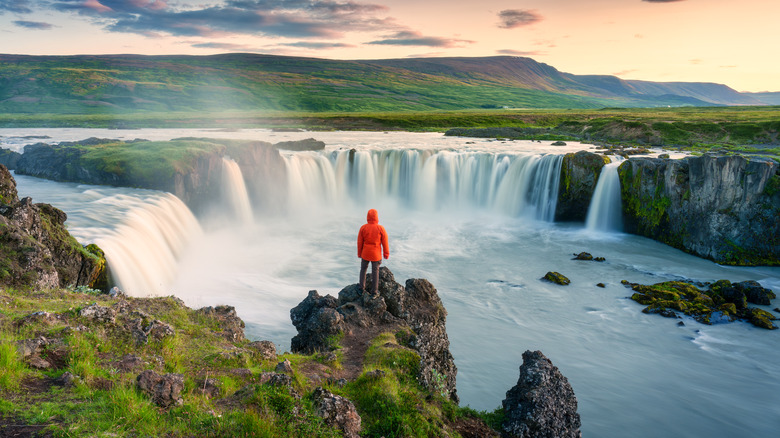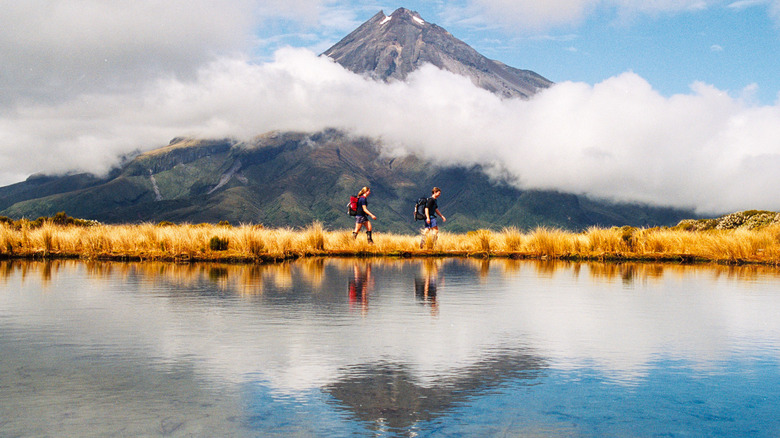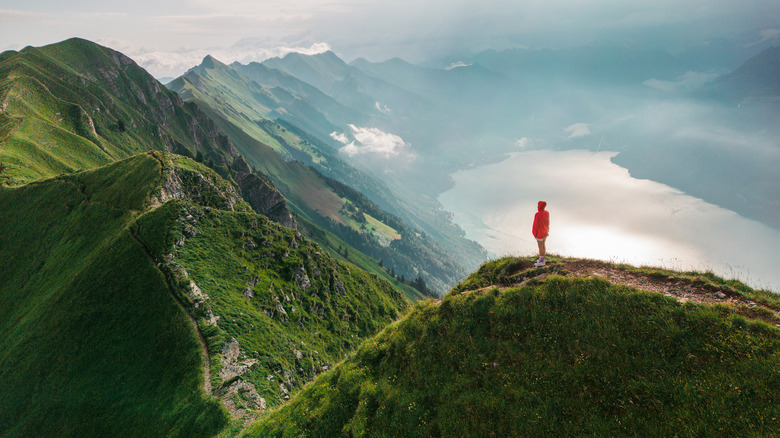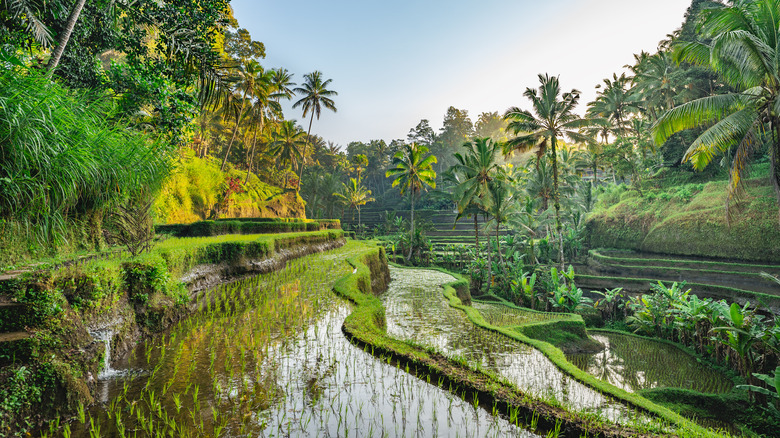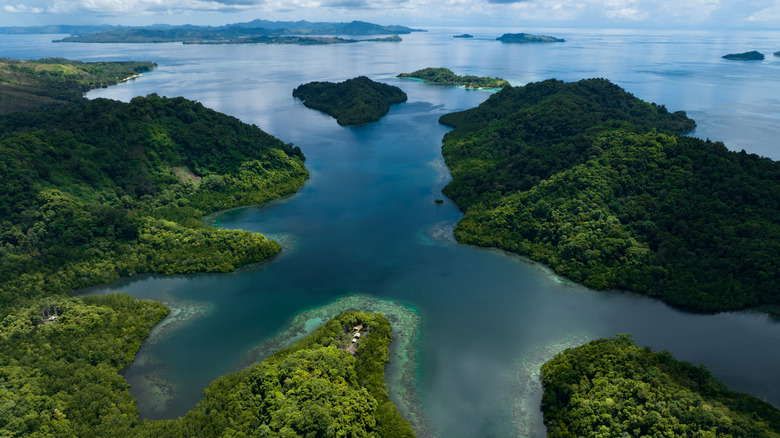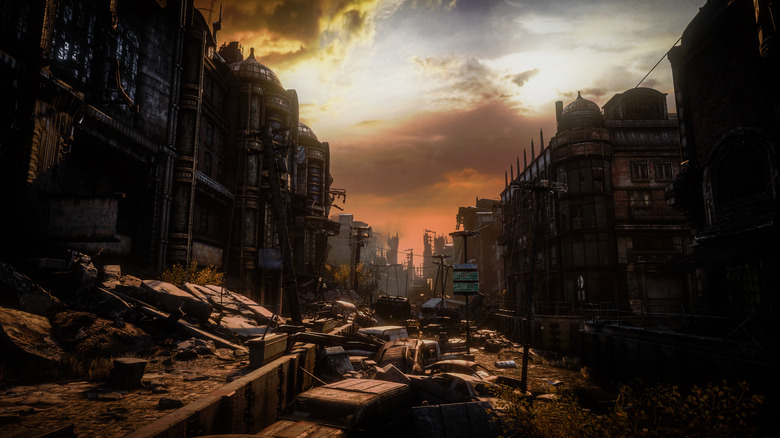What Countries Would Be Safest In World War 3?
No one wants to think about the end of the world as we know it ... unless you're a part of R.E.M. or GenX, in which case, bring on the bologna and potato chip sandwiches, the sweatpants, Crocs, and Ramen, and let's get this show on the road. The history of nuclear weapons is a dark, horrible, incredibly awful chapter in history, and people being people, it's looking like things aren't going to get much better.
Although World Wars 1 and 2 are fading from living memory, they're not so far in the past that we've completely forgotten just what kind of widespread death and destruction they brought. We're also pretty realistic about the possibility of World War 3, and it's safe to say that nuclear bombs — much more powerful than those that leveled Hiroshima and Nagasaki — will be in play. Isn't it a grand time to be alive? Some countries will be first on the hit list, but what about safe spaces?
While we should all probably learn how to maximize our chances of surviving a nuclear attack, the best idea probably involves being well out of the action in the first place. But ... where is that? We hear all about the hotspots all day long, but what are the countries that are going to present the human race with the best chance of survival? Let's talk about the places on Earth that just might become the "Cradle of Life" after we hit the big ol' reset button on ourselves.
(After you've learned where to survive World War 3, check this out to learn more horrifying facts about the largest nuclear weapon ever made.)
Antarctica
First, here's the bad news: If World War 3 ended up being a massive nuclear event — as we can all foresee it being — there's no real safe place on Earth ... only "safer" places. According to computer simulations run by the University of Southampton's Dr. Becky Alexis-Martin and the University of Warwick's Dr. Thom Davies (via The Guardian), one of humankind's best bets is also one of the most inconvenient: Antarctica. They found that the continent was kind of protected by a few things, including the undeniably remote location, a longtime nuclear weapons ban, and the simple fact that there wouldn't be much of a reason for warring countries to waste resources nuking it.
That's not to say that it wouldn't be impacted by World War 3, because it absolutely would. Research done by the American Association for the Advancement of Science found (via National Geographic) that among the lasting impacts of nuclear war would be widespread climate change, including a warming of the poles. That's supported by a study published in the Journal of Geophysical Research: Oceans, which projected major changes for Antarctica.
Like what? Nuclear war and a warming climate would trigger the melting of up to 30% of the sea ice surrounding the continent, which would kick off global cooling and rising waters ... which means that not all of Antarctica would be a safe place to settle. The coasts would likely flood in a domino effect of shifting, warmer winds, warming oceans, and melting ice ... so if Antarctica's the final destination, stay away from the coast.
Argentina
In 2022, Rutgers University spearheaded a study that looked at the consequences of the nuclear war that would inevitably come alongside World War 3. They were specifically interested in global food supplies following conflict, detonation, and nuclear winter, and it was pretty dire stuff. Nuclear weapons detonated on even a relatively small scale resulted in the decimation of the world's food production, and that's where Argentina comes in. In an interview with Science Friday, study leader Dr. Alan Robock suggested that the key to survival wasn't just being where the nukes weren't, but that it also meant being in a place that could sustain itself afterward. There is, after all, no point in surviving the initial conflict only to die of starvation, exposure, or some other horrible consequence in the following years, and Argentina just might have what it takes to survive.
When he name-checked Argentina as one of the likely candidates, he explained, "We assume that trade would stop. Like we hoarded toilet paper during the pandemic, people would keep their food. So a few countries that don't have many people, that are big exporters now, would have enough food — places like Argentina or Australia."
Tech innovator and entrepreneur Martin Varsavsky agrees, to the point where he and six others bought a ranch in Argentina to be sure they're prepared for just an eventuality. He explained on X (formerly known as Twitter) that Argentina was the perfect sanctuary: Along with citing agricultural self-sufficiency, he also pointed to their non-intervention policies, remoteness from conflict hotspots, and the fact that it's unlikely to be a major target.
Australia
Along with Argentina, Rutgers University's Dr. Alan Robock gave Australia a shout-out in an interview where he spoke about their findings on surviving a post-apocalyptic nuclear winter, and the inevitable food shortages that would follow. In an interview with Cosmos, study co-author Dr. Ryan Heneghan from Queensland University explained Australia's very southern location positioned it on the other side of the globe from where nuclear weapons were likely to be deployed, giving it some kind of protection — although it would still see impacts from soot and debris that ends up in the air. Australia, however, is likely big, rich, expansive, and self-sufficient enough to weather not only the fallout, but the collapse of international trade.
In a study published in Discrete Dynamics in Nature and Society in 2022, Australia was named as one of the best places to be in case of nuclear war. Why? In addition to their food production capabilities, they got points for being self-sufficient in terms of energy generation, use, and surplus, a solid, reliable infrastructure, localized governments capable of planning for natural disasters like bushfires and floods, the presence of nearby trading partners, sustainable healthcare, and a standing military.
Heneghan also explained why it's difficult to find a so-called safe country, adding, "There really is no such thing as a regional nuclear war. There's conflict in the world at the moment, that's non-nuclear, and we don't feel the effects of it. But that wouldn't be the case with a regional nuclear war." That said, Australia does have some major things going for it.
Iceland
Iceland is a bit of a tricky one. While it's likely to be impacted by the inevitable nuclear weapons that will be detonated as a part of World War 3, it does have some things going for it that make it likely to become a refuge — starting with the fact that while they don't bear the burden of funding and feeding a standing army, they do have coastal and air defense facilities. Even if it were to be a target, likelihood of a strike is small. That's the first very important step to safety.
They're one of a few countries named as a potential safe space in a 2022 study published in Discrete Dynamics in Nature and Society, which found that Iceland's location presented it with a unique benefit. Climate models suggest that the island nation would suffer impacts of nuclear winter that are much less pronounced than what would destroy other countries in the Northern Hemisphere. They also rely on hydroelectric power, are increasingly dependent on hydrogen fuel, and since they don't rely heavily on imports, the failure of the world's trade networks wouldn't be as badly felt.
Back in 2019, the Reykjavik Grapevine looked at how well-prepared to face nuclear threats Iceland was, and confirmed that there was a plan in place. That included increasing stocks of iodine tablets, which are life-saving in the case of nuclear fallout. Why? Taking iodine overloads the thyroid and prevents it from absorbing radioactive iodine-131, and there's even more good news for Iceland: Native species of kelp are an invaluable, naturally occurring source of this lifesaving mineral.
New Zealand
A 2022 study published in Discrete Dynamics in Nature and Society found that there were a lot of similarities between New Zealand and Australia, as far as survivability during World War 3 and a massive nuclear event is concerned. Like Australia, New Zealand was found to be capable of producing enough food to support their population, especially if their dairy exports stopped and were instead given to the people living there. They were also found to be 76% energy self-sufficient and have a highly educated population, which is important ... especially because they're likely to face big problems relatively quickly.
Study authors did point to difficulties that the disruption of trade networks would bring, saying that the difficulties of shuffling products between islands would likely put a massive strain on energy resources. They also rely on imports for key items like chemicals, oil, and rubber, which could ultimately result in something of a domino effect. Removing building blocks could destabilize the entire nation, so New Zealand's place on the list comes with a caveat.
Study authors write: "This situation may require strict maintenance of law and order, particularly if rationing of fuel, healthcare, or even food is required. Risk of unrest is probably increased if such plans are not publicized ahead of time. ... it may struggle to enforce local rationing if social cohesion falters." In other words, it might survive, but in a "Mad Max" kind of way. Can an entire country work together to comfortably survive the aftermath of a world war? Time might tell.
Switzerland
While many of the safer places in the world rely on being completely out of the way if World War 3 were to break out, Switzerland sits right in the middle of what's likely to be a major conflict. However, they have a few major things going for them, and that only starts with their long-standing policy of neutrality. Switzerland's neutrality policy is among the oldest in the world and held through the first two world wars, so projecting it's going to last through the third isn't much of a leap.
But they also have something else: A massive series of nuclear shelters with enough space for each and every person ... and then some. As of 2022, Switzerland has a population of 8.6 million, and bunkers that could support almost 9 million people. And they're everywhere: Shelters were largely built during the Cold War, were constructed inside and beneath buildings, and have been used for everything from storage to wine cellars in the decades since.
They're outfitted with everything that anyone would need to survive World War 3 and a nuclear attack, and Nicola Squillaci — head of Geneva's civil protection and military affairs division — explained, "It is like a capsule, with airlocks on emergency exits and main exits. If the building were to collapse, the shelter would remain intact." They were built alongside the popularization of the phrase, "Neutrality is no guarantee against radioactivity," and Switzerland's population has also been prepped to know exactly what to do in case World War 3 does happen.
Indonesia and the Philippines
In 2022, the Carnegie Endowment for International Peace took an in-depth look at Indonesia. In particular, they were interested in their stance on the conflict between Russia and Ukraine, and they made it quite clear that they were staying neutral. President Joko Widodo stated, "We should not divide the world into parts. We must not allow the world to fall into another cold war." Interestingly, the report also looked at one of the driving factors behind that, which was maintaining their own regional stability. They relied on imports from both Russia and Ukraine, but according to a study in the journal Discrete Dynamics in Nature and Society, that's precisely the attitude that got them on the list of potentially safe havens during World War 3.
While it was forecasted that Indonesia might struggle with food supplies, maintaining friendly relations and trade with Australia could — in theory — help relieve those problems. In the meantime, Indonesia's neutrality means it's unlikely to be a target. Now, add in their ability to produce much more energy than they consume, and the likelihood that their location will protect them from the worst of a nuclear winter, and that makes them an invaluable cornerstone to area stability.
Indonesia and the Philippines both have something else going for them: Strong local governments, and small, local populations with close ties. While some problems — like the potential of volcanic activity and less-than-ideal infrastructure — mean it might not be a paradise on Earth, it would likely be a reasonably safe area.
The island nations of the Pacific
When Dr. Becky Alexis-Martin of the University of Southampton and Dr. Thom Davies of the University of Warwick decided to use computer models to simulate the massive nuclear annihilation that would likely come with World War 3, they found that getting the farthest away from conflict and nuclear detonation hotspots really did make a difference. Where better to do that than in the middle of the Pacific?
In a piece for The Guardian, they wrote that Easter Island, the Marshall Islands, and Kiribati would likely present some kind of safety for those living there. Similarly, a study published in Discrete Dynamics in Nature and Society added the Solomon Islands (pictured) and Vanuatu to that list. Countless other small islands would undoubtedly afford much the same protections as these, and while creature comforts that we've become used to might become scarce, that's a small price to pay for life. Isn't it?
Study authors found that many of these island nations had maintained lifestyles that allowed them to flourish under circumstances that many other nations would flounder under. They cited things like continued reliance on what they described as "traditional and low-technology production methods," which would allow civilizations to continue to produce food and other essentials in the face of a loss of imports, communications, and trade options. Add in the fact that some are close enough to maintain a relationship with Australia and New Zealand, and it seems likely that these isolated island nations could provide some of the best options for surviving World War 3.
How likely is World War 3?
All in all, there are not too many places that are going to be safe once World War 3 starts. Looking back at the death tolls, widespread devastation, and horrific aftermath that came with World War 2 only gives us a general idea of what World War 3 might bring, and let's just say there's a reason for the quote that is often (but perhaps wrongly) attributed to Albert Einstein: "I do not know with what weapons World War 3 will be fought, but World War 4 will be fought with sticks and stones."
World War 3 has almost happened an unsettling number of times, but how likely is it to happen? Experts can't agree ... and whether that's reassuring or not, that's sort of up to each individual to decide.
While many experts say it's unlikely that conflicts in Gaza and Ukraine will escalate into World War 3, others are quick to point out that the previous two world wars also started as localized conflicts that flared and burned to envelop the globe. Experts interviewed by Sky News said, well ... it wasn't good. Sky News security and defense editor Deborah Haynes said World War 3 was "More likely not than at any time since the end of the last world war," and even more unsettling was the opinion of Hugh Lovatt, senior policy fellow at the European Council on Foreign Relations. He said: "The international order is fraying."
(Wondering what really happens during a nuclear missile strike? Click here to find out.)
